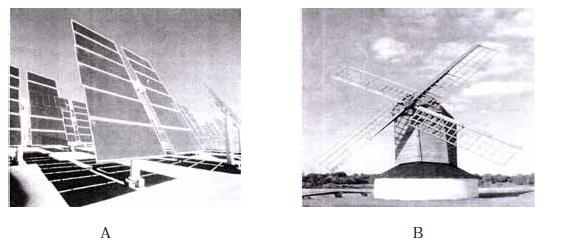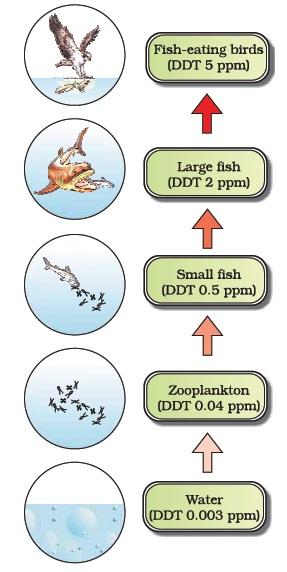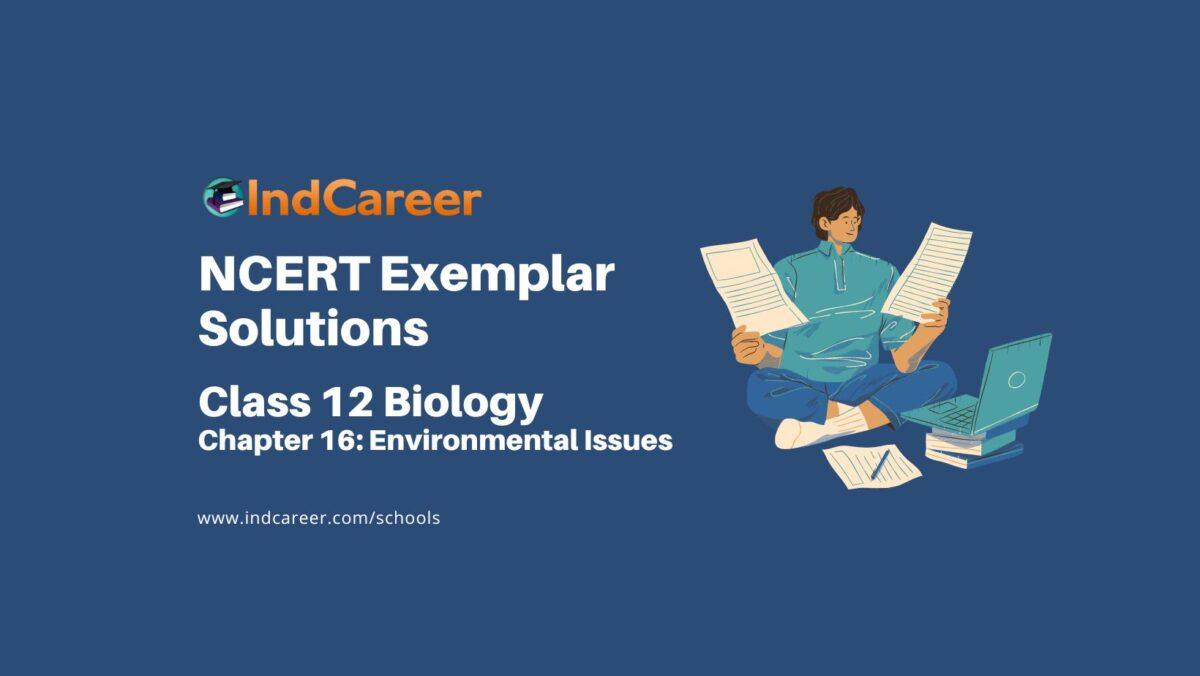NCERT Exemplar Class 12 Biology Chapter 16: Environmental Issues. NCERT Exemplar Solutions for Class 12 Biology Chapter 16 Environmental Issues prepare students for their Class 12 exams thoroughly.
Biology problems and solutions for the Class 12 pdf are provided here which are similar to the questions being asked in the previous year’s board.
NCERT Exemplar Class 12 Biology Chapter 16: Environmental Issues
Class 12: Biology Chapter 16 solutions. Complete Class 12 Biology Chapter 16 Notes.
Multiple Choice Questions
- Non-biodegradable pollutants are created by:
- a. nature
- b. excessive use of resources
- c. humans
- d. natural disasters
- According to the Central Pollution Control Board, particles that are responsible for causing great harm to human health are of diameter:
- a. 2.50 micrometers
- b. 5.00 micrometers
- c. 10.00 micrometers
- d. 7.5 micrometers
- The material generally used for sound proofing of rooms like a recording studio and auditorium, etc. is:
- a. cotton
- b. coir
- c. wood
- d. styro foam
- Compressed Natural Gas (CNG) is:
- a. propane
- b. methane
- c. ethane
- d. butane
- World’s most problematic aquatic weed is:
- a. Azolla
- b. Wolffia
- c. Eichornia
- d. Trapa
- Which of the following causes biomagnification?
- a. SO2
- b. Mercury
- c. DDT
- d. Both b & c
- The expanded form of DDT is:
- a. dichloro diphenyl trichloroethane
- b. dichloro diethyl trichloroethane
- c. dichloro dipyrydyl trichloroethane
- d. dichloro diphenyl tetrachloroacetate
- Which of the following material takes the longest time for biodegradation?
- a. Cotton
- b. Paper
- c. Bone
- d. Jute
- Choose the incorrect statement.
- a. The Montreal protocol is associated with the control of emission of ozone depleting substances
- b. Methane and carbon dioxide are green house gases
- c. Dobson units are used to measure oxygen content
- d. Use of incinerators is crucial to disposal of hospital wastes
- Among the following which one causes more indoor chemical pollution?
- a. burning coal
- b. burning cooking gas
- c. burning mosquito coil
- d. room spray
- The green scum seen in the fresh water bodies is:
- a. blue green algae
- b. red algae
- c. green algae
- d. both (a) and (c)
- The loudness of a sound that a person can withstand without discomfort is about
- a. 150 dB.
- b. 215 dB.
- c. 30 dB.
- d. 80 dB.
- The major source of noise pollution, world wide is due to:
- a. office equipment
- b. transport system
- c. sugar, textile and paper industries
- d. oil refineries and thermal power plants.
- Match correctly the following and choose the correct option
i. Environment Protection Act A. 1974 ii. Air Prevention & Control of Pollution Act B. 1987 iii. Water Act C. 1986 iv. Amendment of Air Act to include noise D. 1981 The correct matches is;- a. i-C, ii-D, iii-A, iv-B
- b. i-A, ii-C, iii-B, iv-D
- c. i-D, ii-A, iii-B, iv-C
- d. I-C, ii-D, iii-B, iv-A
- Catalytic converters are fitted into automobiles to reduce emission of harmful gases. Catalytic converters change unburnt hydrocarbons into:
- a. carbon dioxide and water
- b. carbon mono oxide
- c. methane
- d. carbon dioxide and methane
- Why is it necessary to remove sulphur from petroleum products?
- a. To reduce the emission of sulphur dioxide in exhaust fumes
- b. To increase efficiency of automobiles engines
- c. To use sulphur removed from petroleum for commercial purposes
- d. To increase the life span of engine silencers
- Which one of the following impurities is easiest to remove from wastewater?
- a. Bacteria
- b. Colloids
- c. Dissolved solids
- d. Suspended solids
- Which one of the following diseases is not due to contamination of water?
- a. Hepatitis-B
- b. Jaundice
- c. Cholera
- d. Typhoid
- Nuisance growth of aquatic plants and bloom-forming algae in natural waters is generally due to high concentrations of:
- a. carbon
- b. sulphur
- c. calcium
- d. phosphorus
- Algal blooms impart a distinct colour to water due to:
- a. their pigments
- b. excretion of coloured substances
- c. formation of coloured chemicals in water facilitated by physiological degradation of algae.
- d. absorption of light by algal cell wall.
- Match the items in column I and column II and choose the correct option:
Column I Column II A. UV i) Biomagnification B. Biodegradable Organic matter ii) Eutrophication C. DDT iii) Snow blindness D. Phosphates iv) BOD The correct match is:- a. A ii, B i, C iv, D iii
- b. A iii, B ii, C iv, D i
- c. A iii, B iv, C i, D ii
- d. A iii, B I, C iv, D i
- In the textbook you came across Three Mile Island and Chernobyl disasters associated with accidental leakage of radioactive wastes. In India we had Bhopal gas tragedy. It is associated with which of the following?
- a. CO2
- b. Methyl Iso-Cyanate
- c. CFC’s
- d. Methy Cyanate
Very Short Answer Type Questions
- Use of lead-free petrol or diesel is recommended to reduce the pollutants emitted by automobiles. What role does lead play?
- In which year was the Air (Prevention and Control of Pollution) Act amended to include noise as air pollution.
- Name the city in our country where the entire public road transport runs on CNG.
- It is a common practice to undertake desilting of the overhead water tanks. What is the possible source of silt that gets deposited in the water tanks?
- What is cultural eutrophication?
- List any two adverse effects of particulate matter on human health.
- What is the raw material for polyblend?
- Blends of polyblend and bitumen, when used, help to increase road life by a factor of three. What is the reason?
- Mention any two examples of plants used as wind breakers in the agricultural fields.
- Name an industry which can cause both air and thermal pollution and as well as eutrophication.
- What is an algal bloom?
- What do you understand by biomagnification?
- What are the three major kinds of impurities in domestic wastewater?
- What is reforestation?
- What is the best solution for the treatment of electronic wastes?
Short Answer Type Questions
- Is it true that carpets and curtains/drapes placed on the floor or wall surfaces can reduce noise level. Explain briefly?
- What is hybrid vehicle technology?. Explain its advantages with a suitable example?
- Is it true that if the dissolved oxygen level drops to zero, the water will become septic. Give an example which could lower the dissolved oxygen content of an aquatic body.
- Name any one green house gas and its possible source of production on a large scale. What are the harmful effects of it?
- It is a common practice to plant trees and shrubs near the boundary walls of buildings. What purpose do they serve?
- Why has the National Forest Commission of India recommended a relatively larger forest cover for hills than for plains?
- How can slash and burn agriculture become environment friendly?
- What is the main idea behind “Joint Forest Management Concept” introduced by the Government of India?
- What do you understand by Snow-blindness?
- How has DDT caused decline in bird population?
- Observe the figure A and B given below and answer the following questions

i. The power generation by the above two methods is non-polluting True/False.
ii. List any two applications of solar energy
iii. What is a photovoltaic cell?
Long Answer Type Questions
- Write a short note on electronic waste. List the various sources of e- wastes and the problems associated with its disposal.
- What is organic farming? Discuss the benefits of organic farming as a viable practise in the context of developing nations like India.
- Water logging and soil salinity are some of the problems that have come in the wake of the Green Revolution. Discuss their causes and adverse effects to the environment.
- What are multipurpose trees? Give the botanical and local names of any two multipurpose trees known to you and list their uses.
- What are the basic characteristics of a modern landfill site. List any three and also mention the reasons for their use.
Ans. Characteristics of a modern landfill include:- i. methods to contain leachate such as lining clay or plastic liners.
- ii. compaction and covering of the waste to prevent it from being blown by wind.
- iii. installation of a landfill gas extraction system to extract the gas for use in generation of power.
- How does an electrostatic precipitator work?
- Observe figure and answer the following questions.

i. What ecological term is used to describe the DDT accumulation at different trophic levels?
ii. List any one effect of DDT accumulation on birds
iii. Will DDT accumulation lead to eutrophication?
iv. Does it affect the BOD?
v. Name disease caused by accumulation of any heavy metal.
Answers to Multiple Choice Questions
| 1-c | 2-a | 3-d | 4-b | 5-c | 6-d |
| 7-a | 8-c | 9-c | 10-c | 11-d | 12-d |
| 13-b | 14-a | 15-a | 16-a | 17-d | 18-a |
| 19-d | 20-a | 21-c | 22-b |
